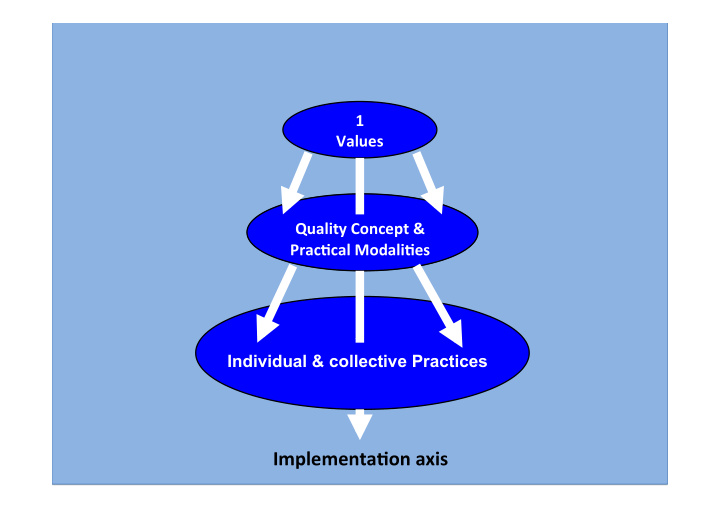



1 ¡ Values ¡ 2 ¡ Quality ¡Concept ¡& ¡ ¡ Prac5cal ¡Modali5es ¡ 3 Individual & collective Practices Implementa5on ¡axis ¡
1 ¡ Values ¡ 2 ¡ Quality ¡Concept ¡& ¡ ¡ Prac5cal ¡Modali5es ¡ 3 Individual & collective Practices Implementa5on ¡axis ¡
To ¡increase ¡crea,vity ¡and ¡innova,on ¡ ¡ • Raising ¡responsibility ¡-‑ ¡Empowerment ¡ • Reflec,ve ¡processes ¡ • Par,cipa,on ¡-‑ ¡coopera,on ¡ • Communica,on ¡ • System ¡thinking ¡ • Balance ¡ ¡ between ¡stability ¡& ¡Flexibility ¡ ¡ ¡ ¡ ¡ ¡ ¡ ¡ ¡ ¡ ¡ ¡ ¡ ¡ ¡ ¡ ¡ ¡Top-‑Down ¡& ¡BoFom ¡Up ¡ ¡ ¡ ¡ ¡ ¡ ¡ ¡ ¡ ¡ ¡ ¡ ¡ ¡ ¡ ¡ ¡ ¡ ¡risk-‑taking ¡& ¡Conformity ¡
How ¡do ¡we ¡prove ¡to ¡others ¡and ¡ourselves ¡that ¡these ¡values ¡are ¡ priori,es ¡ 1 ¡ Values ¡ 2 ¡ Quality ¡Concept ¡& ¡ ¡ Prac5cal ¡Modali5es ¡ 3 Individual & collective Practices Implementa5on ¡axis ¡
Student ¡evalua,on ¡of ¡teaching ¡(SET) ¡ Parameters ¡ ¡ Control Quality ¡ Development Support for
SET ¡as ¡support ¡for ¡professional ¡development ¡ Four ¡basic ¡principles: ¡ ¡ • Confiden,ality ¡: ¡-‑ ¡Who ¡sees ¡the ¡results? ¡ ¡ ¡ ¡ ¡ ¡ ¡ ¡-‑ ¡Who ¡decides ¡what ¡is ¡shared? ¡ ¡ • Responsibility ¡: ¡-‑ ¡Who ¡manages ¡the ¡process? ¡ ¡ ¡ ¡ ¡ ¡ ¡ ¡-‑ ¡Who ¡decides ¡what ¡and ¡when ¡to ¡evaluate? ¡ ¡ • Adaptability ¡: ¡-‑ ¡Who ¡determines ¡the ¡focus ¡of ¡evalua,on? ¡ ¡ ¡ ¡ ¡ ¡ ¡-‑ ¡Can ¡instruments ¡and ¡procedures ¡be ¡modified? ¡ ¡ • Reflec,on ¡: ¡-‑ ¡Is ¡there ¡systema,c ¡support ¡for ¡reflec,on? ¡ ¡ ¡ ¡ ¡ ¡ ¡-‑ ¡Are ¡resources ¡available ¡to ¡support ¡the ¡process? ¡
Development of the Quality Culture 1. Adhesion Axis + people « adhere » 1 + 2 = 2. Deepening Axis Quality Culture Development + domains, + details ¡ 75 ¡ ¡
What People say What people do Individual Level Leadership Staff Students Collective Level Institution Faculty Unit
Challenge ¡ ¡ ¡4 ¡ Ensure coherence of the system
• Regulate« tensions » in Quality system • Make links with general strategy of the university • Offer a support for innovation and change • Ensure continuity
Balance ¡between ¡Autonomy ¡& ¡Accountability ¡ Autority Specificity Transparency ¡ ¡ Reflexion Documentation Confidentiality Uniformity Self-management
• Regulate« tensions » in Quality system • Make links with general strategy of the university • Offer a support for innovation and change • Ensure continuity
Challenge ¡5 ¡ Favour ownership
• “ The ¡general ¡assump.on ¡that ¡is ¡inherent ¡in ¡much ¡ organisa.onal ¡research ¡on ¡the ¡rela.onship ¡ between ¡leadership ¡and ¡culture ¡is ¡that ¡ leaders ¡create ¡cultures ¡… ¡and ¡ cultures ¡yield ¡leaders. ¡The ¡dynamics ¡of ¡this ¡ reciprocal ¡process ¡vary ¡from ¡organisa.on ¡to ¡ organisa.on ” ¡ ¡ Dickson ¡and ¡Mitchelson, ¡2007 ¡ ¡ • ¡ 82 ¡ ¡
• Share one’s vision, values, favour interactions • Ensure coherence between decisions and priority values • Make explicit the relation Decision – Value • Make sure of a good use of resources • Communication « just in time », “repeated”, « referenced », adapted language
Challenge ¡6 ¡ ¡ Preserve ¡a ¡complex ¡ understanding ¡of ¡ Teaching ¡and ¡learning ¡
A ¡linear ¡vision ¡of ¡process….. ¡ ISO Norms ¡ Quality Control ¡ 1987 ¡ 1940 ¡
University ¡
¡ A ¡causal ¡rela,on ¡difficult ¡to ¡show ¡ Quality of Teaching ¡ Indicators � Result Formation � Succes Rate ¡
¡ A ¡causal ¡rela,on ¡difficult ¡to ¡show ¡ Quality of teaching ¡ Selection ¡ Indicators � Result Formation � Expectations of Quality of � Teachers � Sucess Orientation ¡ Rate ¡
Teaching ¡& ¡Learning ¡a ¡complex ¡process ¡ Students profiles Construction Motivation of teaching Efficiency conditions Learning Th.
To conclude… ¡ • A major issue and a critical role for Leadership • Facing several challenges • Critical is the development of a quality culture • It is a long term process
A ¡constant ¡search ¡for ¡balance ¡
Relevance is more important than conformity
Thank you for your attention Jacques.lanares@unil.ch ¡
Learning an invisible process L.O
Recommend
More recommend